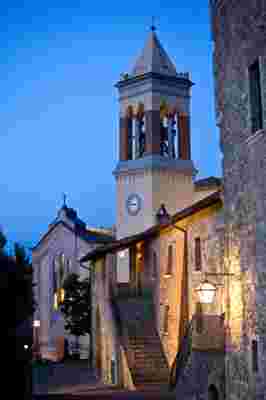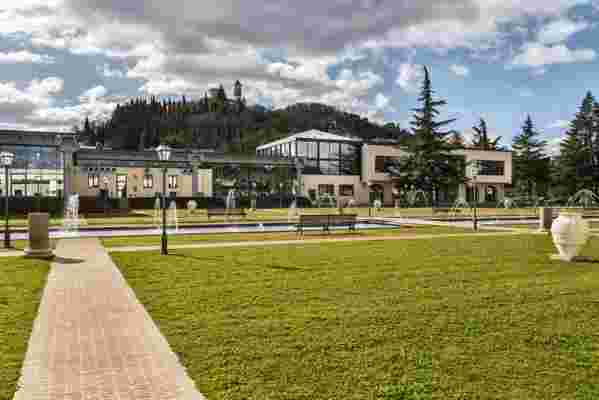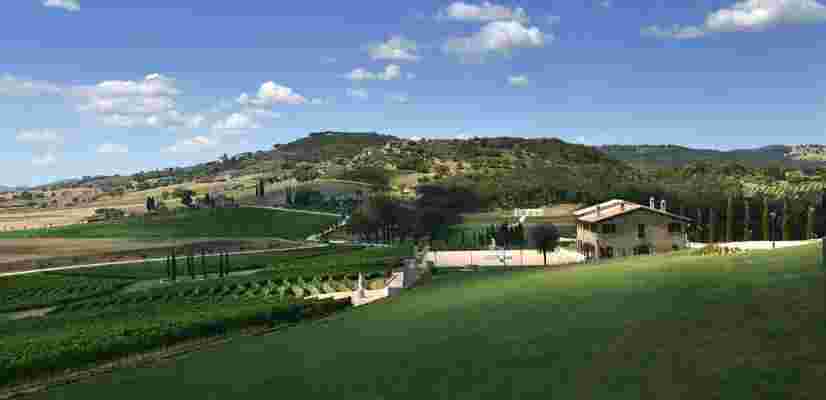Brunello Cucinelli, the Italian impresario of cashmere clothing, has an impassioned, mesmerizing, almost operatic way of speaking—complete with charades-like gestures and harlequin expressions. Taken in context with his English translator, Cucinelli’s booming proclamations have a cinematic quality, especially on location in the self-made billionaire’s native Solomeo, a hilltop hamlet tucked in the province of Perugia, about 90 miles southeast of Florence.
It’s here, in the town peering down on valleys of rolling hills, olive groves, and pinstripe vines, that Cucinelli lives and runs his global enterprise. (The company was started in 1978 with the equivalent of about $550—a sum he has recently gifted employees to spend on items like books, opera tickets, and museum visits.) He speaks about the location in philosophical terms, the physical embodiment of an ideal. “Over the years, we have restored this hamlet by following the teachings of great architectural masters from the past,” the 65-year-old mogul says. “They showed us the importance of listening to the genius loci of a place—that is the way people live in a given area, the local culture, the respect for the community, and the architecture of these places.”

“I have always been inspired by the spirit of being a custodian,” says Cucinelli. Here, a view of buildings in the center of Solomeo, the Piazza della Pace, and the parish church of Saint Bartholomew at the far end.
Cucinelli’s careful restoration of Solomeo has been billed as his Project for Beauty, or Borgo dello Spirito (“Village of the Spirit”), and it has two distinct parts: the town proper—comprising a new theater, restored church, and public spaces—and the periphery—including the rolling hills (or “Woods of Spirituality”), a new sprawling vineyard, and a large-scale monument, dedicated to human dignity.
It comes as little surprise, then, that dignity is a major theme for the region’s famous benefactor, whose pristine factory at the foot of the town is a light-filled stage. All workers have a mandated hour and a half for lunch, when everyone sits down to a locally sourced meal, accompanied by homemade olive oil, and are required to leave at 5 each day. (Visually minded to the extreme, Cucinelli asks that employees drink out of glasses, not bottles, when sitting at their desks.) “I always had a dream of giving economic and moral dignity to the work of man,” he comments. “I wanted Solomeo to become a place where it is possible to live and work close to home—feel connected to nature, but also utilizing technology with respect to the tradition and history, in a contemporary way.”

The light-filled headquarters and factory, where workers look out on fountains and manicured gardens, sit at the foot of Solomeo.
For however much Cucinelli looks to ancient history for inspiration—he cites Hadrian, Vitruvius, Palladio, and Leon Battista Alberti when describing the design inspiration for his fiefdom—he is very much an innovator, an iconoclast to the core. He’s a favorite of Silicon Valley, where Mark Zuckerberg wears $300 custom Cucinelli gray T-shirts, and an in-demand speaker at conferences, including the New York Times ’ Athens Democracy Forum this month. But mind, it wasn’t always so easy to do business in the breadbasket of Italy, despite its many charms. There was a time when Cucinelli, who grew up in a house without electricity, would schedule important work calls so whomever was on the other end would hear Solomeo’s evening bells ringing in the background.
“I’m confident that thanks to today’s advances in technology, we can easily imagine a world where it is possible to work in small villages, even in the United States,” he says. “In these locations here in Italy, there is no loneliness or spiritual poverty—the sense of community in a smaller town is much stronger, and this enhances the quality of life.” As a lucky guest in Cucinelli’s estate at the center of town, with its casually flawless interiors, it’s tough to argue with his point of view.

A view from town overlooking the newly beautified valley, where disused warehouses once stood.
Cucinelli detests the idea that the future of ancient cities and towns is only for tourism. “I imagine them being populated by individuals that work and live there,” he says, “and pleasant outlying areas that start in the periphery and extend to the countryside.” The town of Solomeo, built in the late 12th and early 13th centuries, is home to 500 or so residents, in addition to Cucinelli and his immediate family. (His two daughters, both married, live in homes down the road; one was wed on the premises this year.) The refurbished village now includes a meticulously restored 18th-century church, academies for children, and a new amphitheater and theater, whose 200-seat “noble interior is adorned in soft hues and with the austere lines of rough oak trusses,” reads a company pamphlet, reminding one of just how important aesthetics are in every aspect of the project.
The Tribute to Human Dignity monument, where inscriptions listing the five continents appear under each arch. Africa is situated beneath the central arch to commemorate the origins of mankind.
The most recent additions to the “periphery” include the aforementioned monument, the idea for which came from Cucinelli’s desire to leave a lasting symbol of his dedication to humanity. Measuring about 16-feet high and 80-feet wide, the curving travertine structure has five arches and bronze letters that spell out, in Italian, the words “Tribute to Human Dignity.” Just opposite spans another recent component of the project, a winemaking operation and cantina (a deceiving word for an imposing villa), which overlooks the vineyard. Sentry-like rose bushes stand at both ends of every row.
Solomeo’s beautification effort, in which various neglected warehouses and other eyesores were razed, has been bankrolled by the Cucinelli family foundation for an unknown sum. But the payoff is evident and almost palpable, particularly as the brand’s new generation of savvy customers demand products that reflect dedication to sustainability and craftsmanship. Moving away from planet-destroying industrial processes is at the core of the company’s mission, as is a return to simpler times. In the future, Cucinelli explains, true luxury will mean “the ability to lead a private life unknown to our life partner—our smartphone.”
Just beyond the amphitheater is the newly built theater, which Cucinelli describes as the secular temple of Solomeo, dedicated to the arts. “I believe we are all called in some way to restore beauty, humanity, and truth in the world,” he says.
In the end, Cucinelli emphasizes the importance of equilibrium in all things—“a focus on excellence and a modern approach through the lens of core values from the past,” he notes. Asked about how the Project for Beauty reflects him, as a man, and his eponymous label, Cucinelli pauses. “I believe this project represents that much-loved dream of Solomeo,” he says, “which consists of working and living while respecting those around us by continually looking for a feeling of temporary custody, of a very small part of creation—imagining that this last one can always illuminate our path.”
RELATED: A Home In Tuscany Undergoes A Magnificent Makeover
